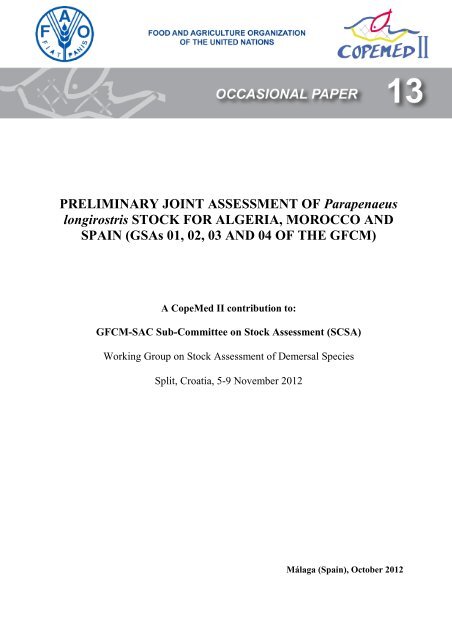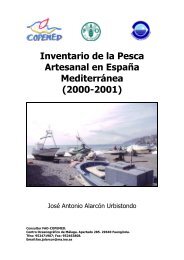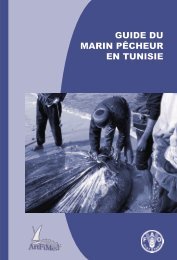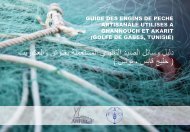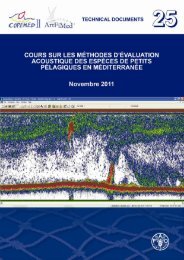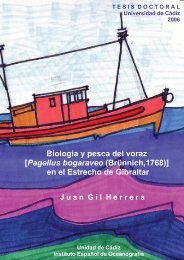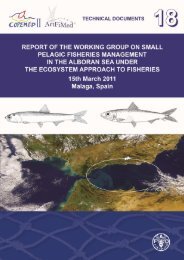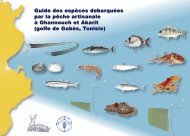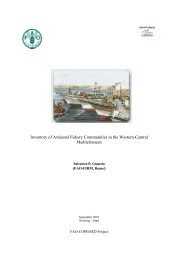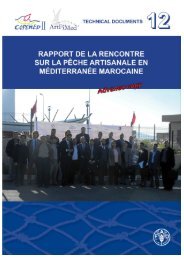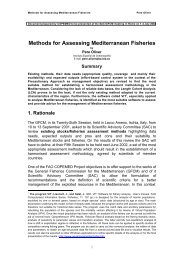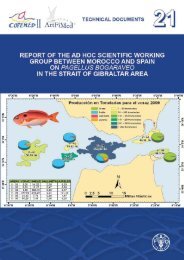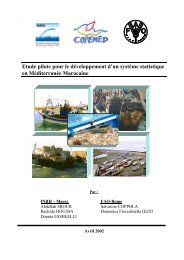OP13 - Fao - Copemed
OP13 - Fao - Copemed
OP13 - Fao - Copemed
You also want an ePaper? Increase the reach of your titles
YUMPU automatically turns print PDFs into web optimized ePapers that Google loves.
PRELIMINARY JOINT ASSESSMENT OF Parapenaeuslongirostris STOCK FOR ALGERIA, MOROCCO ANDSPAIN (GSAs 01, 02, 03 AND 04 OF THE GFCM)A CopeMed II contribution to:GFCM-SAC Sub-Committee on Stock Assessment (SCSA)Working Group on Stock Assessment of Demersal SpeciesSplit, Croatia, 5-9 November 2012Málaga (Spain), October 2012
CopeMed II Occasional Paper Nº 13(GCP/INT/028/SPA – GCP/INT/006/EC)CopeMed II (Co-ordination to Support Fisheries Management in the Western andCentral Mediterranean) is a project under the responsibility of the Fisheries andAquaculture Department of the Food and Agriculture Organization of the UnitedNations (FAO), executed by the Marin and Inland Fisheries Service and Coordinatedfrom the Office of the Project in Málaga (Spain).CopeMed II is financed by the DG Mare of the European Commission and theGovernment of Spain.CopeMed II Occasional Papers is a series of non peerreviewed documents prepared in the frame of theactivities of the Project in cooperation with the CopeMedII countries, other FAO Mediterranean projects or byother reasons for: technical support to internationalmeetings, working group meetings, joint assessmentmeetings on shared stocks within the CopeMed regionand with other FAO projects; and report concerning otheractivities.The documents included in the Occasional Papers seriesare based on work carried out by researchers from theinstitutions involved in CopeMed II, on contributionsprepared by external experts to the project and on jointworks organized by or with the support of other FAOprojects.CopeMed II Occasional Papers are available on thewebsite of the CopeMed II Project www.faocopemed.orgFor reference, this document should be cited as follows:Benchoucha S., Pérez Gil J.L., Ainouche N., Jarbui O., Baro J., Elouamari, N., Ben Merien S.,Hamida C., García T., Bernardon M., Camiñas J.A., Fernández I.L. Preliminary joint assessmentof Parapenaeus longirostris stock for Algeria, Morocco and Spain (GSAs 01, 02, 03 and 04 of theGFCM). Paper presented at the Working Group on Stock Assessment of Demersal Species (SCSA-SAC, GFCM), (Split, Croatia, 5-9 November 2012). GCP/INT/028/SPA-GCP/INT/006/EC.CopeMed II Occasional Papers nº 13: 14 pp.1
GENERAL FISHERIES COMMISSIONFOR THE MEDITERRANEANCOMMISSION GÉNÉRALE DES PÊCHESPOUR LA MÉDITERRANÉEGFCM-SAC Sub-Committee on Stock Assessment (SCSA)Working Group on Stock Assessment of Demersal SpeciesSplit, Croatia, 5-9 November 2012PRELIMINARY JOINT ASSESSMENT OF Parapenaeuslongirostris STOCK FOR ALGERIA, MOROCCO ANDSPAIN (GSAs 01, 02, 03 AND 04 OF THE GFCM)(CARRIED OUT IN THE FRAMEWORK OF THE CopeMed II STUDY GROUP ON P.longirostris, Málaga, Spain. 24-26 September 2012, IN SUPPORTING THE GFCMASSESSMENT FORM)2
presented at the GFCM-SAC Working Group on Stock Assessment of Demersal Species(Chania, October 2011).The outcomes of the meeting held in Fuengirola and the recommendations of the GFCM-SACDemersal Working Group on the joint stock assessment suggested completing and updating thedatabase already used during the first meeting of the CopeMed II study group and carrying outa new joint stock assessment to cover all the study area. In order to accomplish this assignment,CopeMed II organized the Second meeting of the study group on Parapenaeus longirostrisstock for Algeria, Morocco and Spain (GSAs 01, 02, 03 and 04 of the GFCM) in Málaga, (24-26 September 2012). The meeting was attended by experts from the Centre National deRecherche et de Développement de la Pêche et l’Aquaculture (CNRDPA, Algeria), theNational Institute of Fisheries Research (INRH, Morocco), the Spanish Institute ofOceanography (IEO), the Institut National de Sciences et Technologies de la Mer (INSTM,Tunisia), and the CopeMed II Project’s staff.2. Preliminary joint stock assessment using VIT ProgramSelection of biological data and parametersCatch data, length distributions, age distributions, mean weights, maturity ogive and naturalmortality used in the assessment are included in the GFCM form.The study group decided updating the LCA-VPA assessment with the Moroccan and theSpanish total length frequencies from 2009 till 2011 to make a pseudo-cohort analysis.The study group agreed on using the low growth hypothesis parameters set (García et al, 2009),from GSA 01.For the length weight relationship and the von Bertalanffy growth function, the parametersvalues used are presented in Table 1:Length weightrelationshipa 0.0019b 2.6113von Bertalanffy0.3903Kyear -1Linf 45 mmt0 0.1019Table 1. Length weight relationship and von Bertalanffy growth function parameters values used in theassessment.Female L 50 maturity was assumed = 25.65 mm CL (García et al, 2009). This value comes fromfitting the observed values to a logistic function:Parameter Valuea -5.77b 0.22Table 2. Parameters of the logistic function.Natural mortality (M) vector used was from the literature (Abella et al, 2002).Demersal Species (SCSA-SAC, GFCM), (Chania, Crete. Greece, 24-29 October 2011). GCP/INT/028/SPA-GCP/INT/006/EC. CopeMed II Occasional Papers nº 12: 13 pp.4
The study group decided to update the LCA assessment with the available data from Moroccanand Spanish length frequencies (2009-2011) using the VIT software. The study group run aYield Per Recruit analyses (YPR) (Beverton and Hold, 1957) and Spawning Stock Biomass perRecruit (SSB/R) (Gabriel et al, 1989) to calculate the biological reference points F max and F 0.1with the output results of the VIT, by using the VIT software and an ad-hoc Excel sheet.The input values used in the YPR and SSB/R analysis for the exploitation pattern wereobtained from the VIT results. Exploitation patterns, weights and maturities by age arepresented in Table 3 (weights are Kg):Age F M Stock Weight Catch Weight Maturity0 0.008 0.82 0.502 0.502 0.010300131 0.395 0.388 4.427 4.427 0.19816092 1.429 0.227 10.533 10.533 0.58961393 0.994 0.2 17.605 17.605 0.83134754 0.984 0.2 23.483 23.483 0.9413755+ 0.3 0.2 28.29 28.29 1Table 3. Input values by age used in the YPR and SPR analysis. F and M selectivity, stock and catchweights in kilograms and maturity proportion.Assessment exerciseWith the available data, the study group tried different assessment models. The first one was anupdate of the assessment made in 2010 with the VIT program. The analytical assessmentexercise was carried out using pseudo-cohorts (2009-2011) with the VIT software. Moroccan(GSA 03) and Spanish (GSA 01) length-size composition (LC, mm) data were used to makethe pseudo-cohort analysis. Biological input data for relative and absolute growth, naturalmortality (M) and maturity at age were also endorsed by the group.Considering that exclusively length-size composition data from 2010 in Algeria were available,the group agreed to perform a length cohort analysis (LCA) exercise only for 2010, by usingthe length-size composition data from Algeria, Morocco and Spain.After this first step, the group used four different F terminal values (F=0.3, 0.5,1 and 1.5) andpointed out that ages are relative to the first length of the analyses. Figure 1 shows the resultsfor F by length classes and by age for the four different values of terminal F.Figure 1. VIT results for F by length classes and by age for the four different values of F terminal.5
class age Ft_0.3 Ft_0.5 Ft_1 FT_1.51 0.008 0.008 0.008 0.0082 0.395 0.399 0.402 0.4033 1.429 1.467 1.497 1.5074 0.994 1.084 1.163 1.1915 0.984 1.264 1.628 1.801Fbar2-41.1356 1.271 1.1350 1.4293Table 4. VIT estimates of fishing mortality (F) by age and the average fishing mortalities for class ages2-6 (Fbar) for the four different levels of terminal F (0.3, 0.5, 1,1.5).The study group agreed to take the VIT results for the terminal F = 0.3 as the best round to tryan YPR analysis with the NOAA software. The inputs for YPR analysis were presented.A length cohort analysis (LCA) and a virtual population analysis (VPA) were performed in afirst step for all length-size composition. Figure 2 presents the VIT results for F by lengthclasses.1.41.2F (LCA)10.8F0.60.40.209 11 13 15 17 19 21 23 25 27 29 31 33 35 37 CL(mm)Figure 2. VIT results for Fishing mortality by length (LCA) and age (VPA) classes.In the SSB/R analyses, the group decided to use F 0.1 as the biological reference point. Thisreference point appeared to be precautionary and sustainable and can be used as F msy proxy formost of the demersal species analyzed.6
Figure 3. Yield Per Recruit (YPR) and Spawning Stock Biomass per Recruit (SSB/R) by F. The Fvalues are referring to F at age 5.Reference Point F YPR SSBRF Zero 0 0 34.86F-0.1 0.3746 2.5913 10.55F-Max 0.6356 2.768 5.72F-Reference 1.135 2.602 2.69Table 5. Fishing mortality (F) biological references points and their Yield Per Recruit (YPR) andSpawning Stock Biomass per Recruit (SSB/R) values.The actual level of fishing mortality (Fbar = 1.135) is higher than the values calculated for theF msy proxi (F 0.1 = 0.3746) showing that the stock status is currently overfished. Based on theseresults:Transition analysisA transition analysis was carried out decreasing the current trawl effort by 20% of the currentvalue (from 5 to 4 days/week).The simulation conditions were the following:- LCA, developed on a mean pseudocohort (year 2003).- Prediction of 20 years.- Recruitment independent from the stock (non stock–recruitment relationship).The change of the current trawl effort would produce an increment only in the B/R and SSB/R.After the application of this management measure, in the third year, a recovery of the stock canbe observed.7
Figure 4. Results of the transition analysis.Recommendations- The SG recommended a 50% reduction of the current fishing mortality in the trawlfisheries targeting P. longirostris.- According to this recommendation, the SG stressed that the actual effort level in thetrawl fisheries should be reduced to adjust the current fishing mortality to levels more inagreement with the sustainability values, with F0.1 as reference point (VPA analysis).- The SG agreed that a sensitive analysis of the most representative parameters used inthe joint assessment (L∞, K, F, a, b, t 0 …) should be carried out after the jointassessment.3. Global approach of the deepwater pink shrimp stock evaluation for Algeria, Moroccoand Spain (GSAs 01, 02, 03 and 04)Description of the model usedThe deepwater pink shrimp (Parapenaeus longirostris) stock in the Algeria + Morocco + Spainregion was evaluated with the "Biodyn" production model based on the Schaeffer model,updated and performed by Mr. Pedro Barros (FAO).8
The model uses four essential parameters: carrying capacity biomass (K), intrinsic growth rateof the population (r), initial depletion (D) (initial biomass relative to K) and catchabilitycoefficient (q). All other parameters estimates derived from these four parameters.After giving the best estimates of these parameters, the model calculates the reference pointsMSY, B MSY and F MSY . It calculates the reference points Bratios =BCurBMSYB1et CurB M 0,(ratio between the estimated biomass for the last year of data series and B MSY orB 0,1 ) and Fratios = F F and F CurF 0, 1 (ratio between the fishing mortality of the stockCurMSYin the last year of data series and the optimal fishing mortality F MSY or the target fishingFmortality F 0,1 ). It also calculates the Fratio = CurFSYCur(Ratio between the coefficient offishing mortality observed the last year of the data series and the coefficient that would give asustainable capture at current biomass levels).The absolute values of F MSY , B MSY and K should not be taken into consideration, given that themodel provides a more accurate estimate for Fratios and Bratios.Trends of these ratios and whether they are above or below 1.0 (100%) provide usefulinformation to management.Bratios:B CurBMSYet B CurB 0, 1indicate the current status of the stock compared to the biomassthat would be produced by MSY. Values below 100% indicate an abundance of the stockbelow B MSY or B 0.1 while values above 100% indicate an abundance higher than B MSY or B 0.1 .FFratios : CurFSYCur, FCurFMSYet F CurF 0, 1measure the level of exploitation in the last yearwith available data, as a proportion of the necessary level of exploitation to extract thesustainable capture, the optimal production or the production related to the estimated biomasslevels in the same year. Values below 100% indicate a situation of potential growth of thestock, while values higher than 100% suggest that the stock will decline the next year. Theindices B cur/B MSY and F cur /F MSY have been used as Limit Reference Points (LRP) while theindices B cur /B 0.1 and F cur /F 0.1 were chosen as Target Reference Points (TRP).This model and its adjustments were recorded on Excel with an observation error model(Haddon, 2001). The model was fitted to the data by using the Excel’s nonlinear optimizationfunction: the solver function.Used dataThe source data used for the P. longirostris stock were the total annual catch of this species inAlgeria, Morocco and Spain for the period 2003-2011 and 5 analyses with annual abundanceindices (indices of abundance of scientific surveys in Morocco, indices of abundance fromscientific surveys in Spain, CPUE of the coastal trawl commercial fishery targeting this speciesin Spain, CPUE of the coastal trawl commercial fishery targeting this species in Morocco andthe overall CPUE of the commercial trawl fishery in Algeria) for the same period.9
Assessment ResultsThe five series of abundance indices used are fitted with the model. Indices of abundance of thescientific surveys in Morocco and the CPUE of the commercial trawl fishery targeting thisspecies in Spain were, however, the indices of abundance that showed the best fit with themodel.Index of abundance F cur /FSY cur F cur /F 0.1 F cur /F MSY B cur /B 0.1 B cur /B MSY RFirst analysis : Indices of abundance ofscientific surveys in Morocco (kg/h) 26% 41% 37% 52% 57%Second analysis : Indices of abundance ofscientific surveys in Spain (kg/km²) 40% 32% 29% 118% 129%Third analysis : CPUE of the commercialtrawl fishery targeting this species inMorocco (kg/fd)Fourth analysis : CPUE of the commercialtrawl fishery targeting this species inAlgeria (kg/fd)Fifth analysis : CPUE of the commercialtrawl fishery targeting this species in Spain(kg/fd)113% 17% 15% 170% 187%120% 15% 13% 172% 189%125% 263% 236% 10% 11%Table 6. Results of the evaluations of the state of exploitation of the Parapenaeus longirostris stockobtained by 5 series of the indices of abundance with the total catch of the stock in the CopeMedsubregion: Algeria+Spain+Morocco (GSA 04+01+03).Fcur / FSYcur: Ratio between the coefficient of fishing mortality observed the last year of thedata series and the coefficient that would give a sustainable capture at current biomass levels.Fcur/F0.1: Ratio between the coefficient of fishing mortality observed the last year of the dataseries and the target mortality coefficient F0.1.Fcur / FMSY: Ratio between the coefficient of fishing mortality observed the last year of thedata series and the mortality coefficient that would give a long term maximum sustainablecapture.Bcur/B0.1: Ratio between the estimated biomass observed the last year of the data series andthe biomass corresponding to F0.1.Bcur / BMSY: Ratio between the estimated biomass observed the last year of the data seriesand the coefficient of biomass corresponding to FMSY.Discussion of the resultsThe Study Group decided to adopt, however, the results obtained with the CPUE of thecommercial trawl fishery targeting this species in Spain and the series of total captures of thisstock considering that CPUE series was the only data that lead to the same conclusionsobtained by analytical models.The adopted abundance indices series fits well with the model used. The obtained results give aMSY of 6059 tons, Bratios (Bcur/B0,1 and Bcur / BMSY) of 10% and 11% respectively andFratios (Fcur / FSYcur, Fcur/F0,1 and Fcur / FMSY) of 125%, 263% and 236% respectively.0,9210,5890,6250,8710,76710
350030002500Observed and predicted Abundance IndicesObsAbIndex PredictedAbIndex Catch25002000Abund. Index20001500100050015001000500002002 2003 2004 2005 2006 2007 2008 2009 2010 2011 2012Figure 5. Adjustment of the Biodyn model with the CPUE of the Spanish commercial trawl fisherytargeting the deepwater pink shrimp and the total catch of this species in the CopeMed subregion:Algeria+Spain+Morocco.DB/DtMSYStock ParametersMSY 6059BMSY 15000B0.1 16500Cur_Stock 1632B/BMSY 11%B/B0.1 10%Cur_SustProd 1247Cur_PercProd 21%CurY 1558FMSY 0,40F0.1 0,36FCur 0,95Fcur/FMSY 236%SY CurFcur/F0.1 263%FSYCur 0,76Fcur/FSYCur 125%DBCur -311DBCUr/Bcur -19%CurY/MSY 26%Y CurB 0.1B/KBcurB MSYFigure 6. Summary of the results on the state of the Parapenaeus longirostris stock in the CopeMedsubregion: Algeria+Spain+Morocco.The obtained results indicate that the deepwater pink shrimp stock is overexploited, withcaptures that exceed the natural production of the stock. Current biomass represents only 10%of the target biomass and the fishing mortality exceeds 2.6 times the target mortality.The results obtained for the Fratios are higher than 100% (Table 5, Figure 2), showing that thefishing mortality exceeds the target mortality and the mortality producing an optimal yield. Theratio Fcur / FSYcur is 125%, showed a decreasing trend of the exploitable stock for the nextyear. The ratios (Bcur/B0,1 and Bcur / BMSY) are respectively 10% and 11%. Current biomassrepresents only 10% of the target biomass and 11% of the optimal biomass. These results show11
that the stock of deepwater pink shrimp in the CopeMed region (GSAs 01, 03 and 04) isoverexploited with a fishing mortality rate that exceeds 2.6 times the target fishing mortality(F0.1).The predictive model shows that only a reduction of the current fishing mortality in the trawlfisheries targeting P. longirostris in the subregion: Algeria+Spain+Morocco can allow therecovery of the stock nearly to its optimal level (figures 7 and 8).120%P. longirostris (Reduction of F by 50%)Catches (Relative to MSY)MSY100%Relative Catches80%60%40%20%0%2003 2005 2007 2009 2011 2013 2015TimeCatches MSY Sust. CatchesFigure 7. Results of the prediction analysis on catches by a 50% reduction of the fishing effort in thesubregion: Algeria+Spain+Morocco.UMSY 120% U0.1P. longirostris (Reduction of F by 50%)Predicted Abundance Indexes (Relative to U0.1)100%Relative Abund. Index80%60%40%20%0%2003 2005 2007 2009 2011 2013 2015TimePredicted Rel Ab. Indx Rel Ab. Indx MSY Rel Ab. Indx 0.1Figure 8. Results of the prediction analysis on abundance index by a 50% reduction of the fishing effortin the subregion: Algeria+Spain+Morocco.12
Useful management recommendationsAccording the predictive model results, the SG recommended a 50% reduction of the currentfishing mortality in the trawl fisheries targeting P. longirostris in order to reach the stockrecovery to its optimal level.4. Recommendations and conclusionsBased on the results of the two joint assessments analyses (analytical and production models)the SG agreed to carry out a sensitive analysis of the most representative parameters used in thejoint assessment (L∞, K, F, a, b, t0…).General recommendations:- Data from Algeria and Morocco on length-frequency distribution at landing arenecessary and should be provided for the next meeting of the SG to improve the jointdatabase used in the analyses carried out by the SG, with partial support of CopeMed IIif necessary.- The organization of a joint stock assessment meeting with the Sicily Strait area SG for ajoint evaluation of P. longirostris.- The biological and fisheries data in each country used for the assessment (biologicalparameters, demographic structure, etc.) will be uploaded to the CopeMed web(Regional Networks and databases).- To carry out predictive analysis to complete the assessments.- To reinforce the SG stock assessment results by incorporating to the SG socioeconomicinformation and data from experts on this field. The SG recommended CopeMed II toprepare the TORs for this matter.- The SG agreed that Mr. Benchoucha (INRH, Morocco) should be in charge ofpresenting the assessment in the next meeting of the SAC-SCSA WG on DemersalSpecies.- CopeMed II expressed the willingness to support this participation.Recommendations from the results of the analytical model (GSAs 01 and 03):- The SG recommended a 50% reduction of the current fishing mortality in the trawlfisheries targeting P. longirostris.- According to this recommendation, the SG stressed that the actual effort level in thetrawl fisheries should be reduced to adjust the current fishing mortality to levels more inagreement with the sustainability values, with F0.1 as reference point (VPA analysis).Recommendations from the production model results (GSAs 01, 03 and 04):- The SG recommended a 50% reduction of the current fishing mortality in the trawlfisheries targeting P. longirostris.- According to this recommendation, the SG stressed that the actual effort level in thetrawl fisheries should be reduced to adjust the current fishing mortality to levels more inagreement with the sustainability values, with f 0.1 as reference point (Schaeffer model).- According to the projection coming from the production model, the SG agreed that thereduction of the fishing mortality (F) at the mentioned level could permit the recoveryof the P. longirostris stock in 4-5 years.13
5. Future researchThe SG recommended the realization of the following actions:- To improve the current biological sampling of the landings of this species in Algeria,Morocco and Spain with the support and assistance of the national administrations andthe regional projects, with the objective of having a regular coverage of the landings ofthis species at least twice per month.- To estimate the bycatch and the discards at sea caused by P. longirostris fishery inAlgeria, in Morocco and Spain.- To improve the statistical information related to the fishing effort on P. longirostris inAlgeria.6. ReferencesCopeMed II. 2011. Report of the First meeting of the Working Group on Parapenaeuslongirostris stock for Algeria, Morocco and Spain (GSAs 01, 02, 03 and 04 of the GFCM).CopeMed II – ArtFiMed Technical Documents Nº19 (GCP/INT/028/SPA – GCP/INT/006/EC).Málaga, 2011.70pp.Elouamari, N., Perez Gil J.L., Benchoucha S., Garcia T., Ainouche N., Jarboui O., FernándezI.L, Bernardon M. and Caminas J.A. 2011. Advances in the joint assessment of Parapenaeuslongirostris stock for Algeria, Morocco and Spain (GSAs 01, 02, 03 and 04 of the GFCM).Paper presented at the Working Group on Stock Assessment of Demersal Species (SCSA-SAC,GFCM), (Chania, Crete. Greece, 24-29 October 2011). GCP/INT/028/SPA-GCP/INT/006/EC.CopeMed II Occasional Papers no 15: 18 pp.Lleonart J. and J Salat. 1992. VIT Fisheries Analysis Program. Inf. Tec. Sci. Mar. 168-169.Barcelona, July 1992. 116 pp.14


